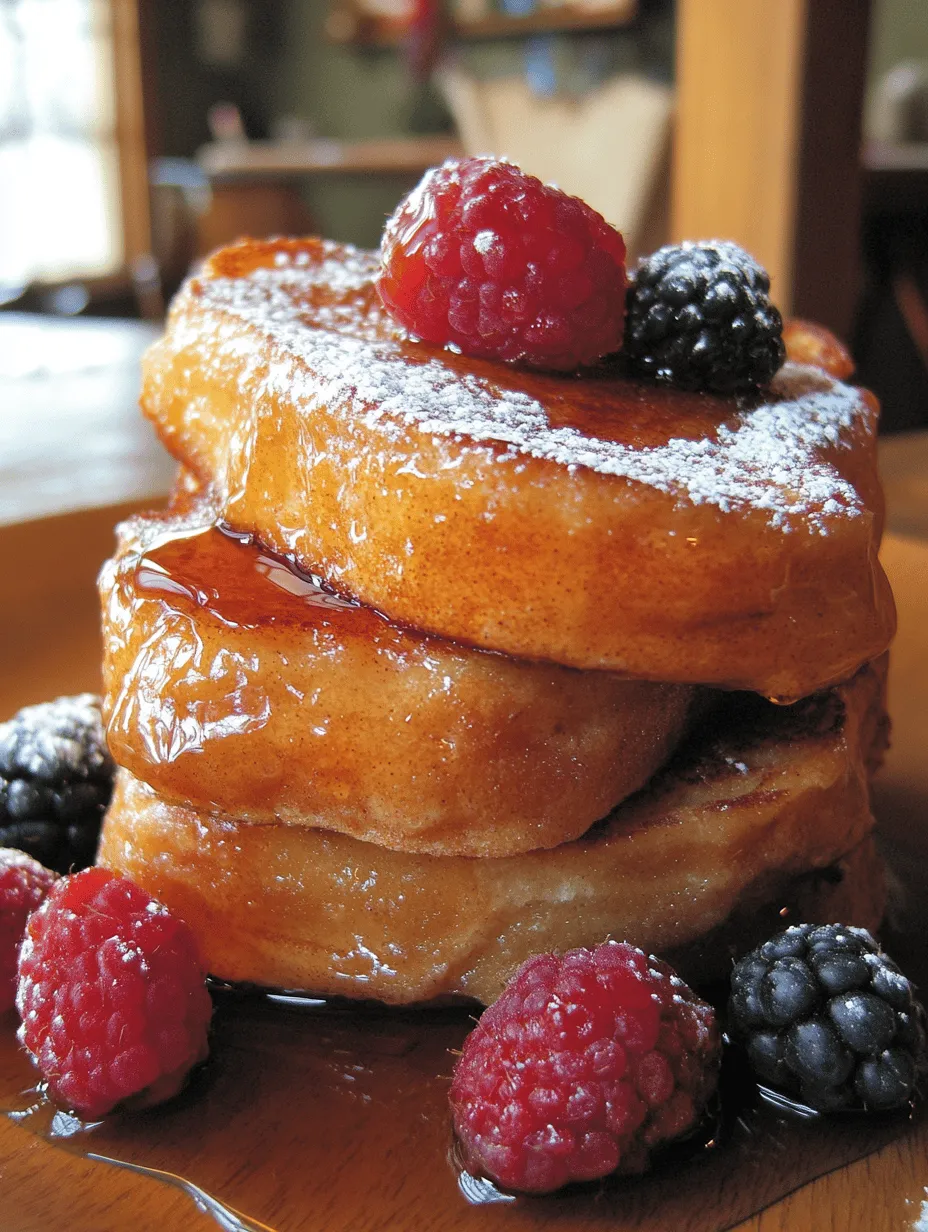Introduction
French toast has long held its place as a beloved breakfast staple, cherished by families and brunch enthusiasts alike. With its warm, comforting flavors and delightful texture, it transforms simple ingredients into a satisfying meal that can be enjoyed any day of the week. Among the myriad of French toast recipes out there, the Cinnamon Delight French Toast stands out as a particularly indulgent variation, offering a perfect balance of sweet and spice that can elevate any breakfast or brunch gathering.
The Cinnamon Delight French Toast is not just another variation; it’s a celebration of flavors that meld together beautifully, providing a delightful experience for your taste buds. Its ease of preparation makes it an excellent choice for family gatherings, special occasions, or simply a cozy morning at home. Whether you’re serving it to guests or treating yourself, this recipe is sure to impress.
The Allure of French Toast
The roots of French toast can be traced back to ancient times, with variations appearing in various cultures around the world. Known as “pain perdu” in France, which translates to “lost bread,” this dish was originally created to prevent food waste by repurposing stale bread. Over the centuries, it evolved, adopting different names and ingredients across various regions. In Spain, it’s referred to as “torrijas,” while in Italy, it is known as “pane fritto.” Each of these versions carries with it the essence of comfort food, designed to nourish both body and soul.
What makes French toast so beloved is its versatility. You can customize it with myriad toppings and accompaniments, from fresh fruits and whipped cream to nuts and flavored syrups. The possibilities are endless, allowing you to adapt the recipe to your tastes and preferences.
Among all the variations, the Cinnamon Delight French Toast stands out for its inviting aroma and rich flavor profile. The addition of cinnamon, a spice known for its warm and sweet notes, elevates this dish from a simple breakfast option to a comforting indulgence. When combined with the creamy custard base and thick-cut bread, it creates a delightful experience that lingers long after the last bite.
Ingredients Breakdown
To create the perfect Cinnamon Delight French Toast, you’ll need a few essential ingredients, each playing a crucial role in achieving a delicious result. Here’s a breakdown of each component:
– Eggs: As the primary binding agent, eggs create a custard mixture that envelops the bread, ensuring a rich and creamy texture. They also contribute to the overall flavor and help achieve that golden-brown finish when cooked.
– Whole Milk: Adding creaminess and richness, whole milk is essential for the custard base. It enhances the flavor and ensures that each slice of bread is perfectly soaked without becoming overly soggy.
– Vanilla Extract: A splash of vanilla extract adds depth to the flavor profile, enhancing the sweetness of the dish without overpowering the other ingredients. It’s a small addition that makes a significant difference.
– Ground Cinnamon: The star ingredient of this recipe, ground cinnamon infuses every bite with its warm, comforting spice. This aromatic spice not only enhances the flavor but also evokes a sense of nostalgia and comfort, making it a classic choice for breakfast.
– Nutmeg: Just a hint of nutmeg complements the cinnamon beautifully, adding a slightly nutty flavor that rounds out the spice blend. Together, they create a complex and satisfying flavor experience.
– Thick-Cut Bread (Challah or Brioche): The choice of bread is pivotal to achieving the ideal texture. Thick-cut bread varieties like challah or brioche are recommended for their ability to soak up the custard without falling apart. Their rich, buttery flavors further enhance the dish.
– Unsalted Butter: Essential for cooking, unsalted butter adds richness and flavor. It also helps achieve a beautifully browned crust as the French toast cooks in the pan.
– Maple Syrup: The classic sweetener for serving, maple syrup adds a natural sweetness that pairs perfectly with the cinnamon and nutmeg. It’s a must-have for drizzling over your finished French toast.
– Fresh Berries and Powdered Sugar: While optional, fresh berries add a burst of color and freshness, making the dish visually appealing. A dusting of powdered sugar can elevate the presentation, making it look as delightful as it tastes.
Preparation Steps
Now that you have a clear understanding of the ingredients and their roles, let’s dive into the preparation steps for creating your Cinnamon Delight French Toast. These step-by-step instructions will guide you through the process, ensuring that every aspect is covered for a flawless execution.
Step 1: Whisking the Custard Mixture
The first step in making your Cinnamon Delight French Toast is to prepare the custard mixture. In a large mixing bowl, crack the eggs and add the whole milk. Using a whisk, combine the ingredients until they are fully incorporated. It’s important to whisk thoroughly to ensure that the eggs are well blended with the milk, creating a smooth custard base. This mixture will coat the bread and infuse it with flavor as it cooks.
Next, add the vanilla extract, ground cinnamon, and a pinch of nutmeg to the mixture. Continue whisking until all the ingredients are well combined. The aroma of the spices should start to fill the air, hinting at the deliciousness that awaits. Ensure that there are no lumps in the mixture, as a smooth custard will lead to a better texture in the finished dish.
Step 2: Preparing the Bread
While whisking the custard, you can prepare your bread. If you haven’t done so already, slice your challah or brioche into thick slices, about 1 to 1.5 inches thick. The thickness is crucial; it allows the bread to soak up the custard without becoming overly soggy. If your bread is stale or a day or two old, it will absorb the custard even better.
Once sliced, you can start soaking the bread in the custard mixture. Place one or two slices of bread in the bowl with the custard, ensuring they are fully submerged. Let them soak for about 30 seconds to 1 minute on each side, allowing the bread to absorb the flavors of the custard. Be careful not to over-soak, as this can cause the bread to disintegrate.
Step 3: Cooking the French Toast
After soaking the bread, it’s time to cook. Heat a large skillet or griddle over medium heat and add a tablespoon of unsalted butter. Allow the butter to melt and bubble, coating the bottom of the pan.
Once the pan is hot and the butter is melted, carefully place the soaked bread slices onto the skillet. Cook for about 3-4 minutes on each side, or until they are golden brown and crispy. Keep an eye on the heat; if the French toast is browning too quickly, reduce the heat slightly to ensure even cooking.
Step 4: Serving Your Cinnamon Delight French Toast
Once the French toast is cooked to perfection, remove it from the skillet and transfer it to individual plates. Drizzle with warm maple syrup, garnish with fresh berries, and dust lightly with powdered sugar for an elegant touch.
This step is where your Cinnamon Delight French Toast truly shines, as the combination of flavors and textures come together for a delightful breakfast experience.
Stay tuned for the next part, where we’ll delve deeper into tips for achieving the best results and answer some common questions about this delicious recipe.
 Categories Breakfast
Categories Breakfast

